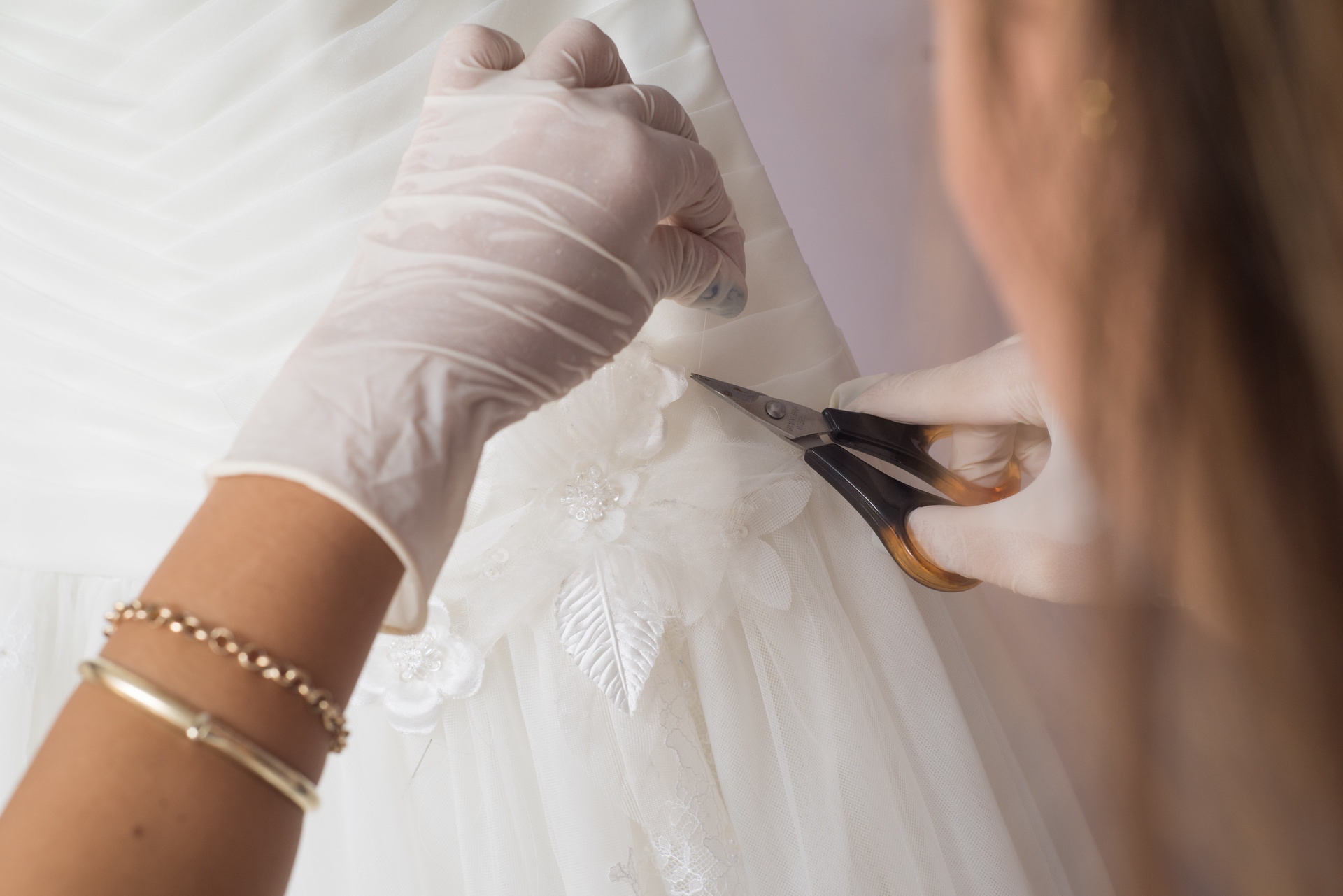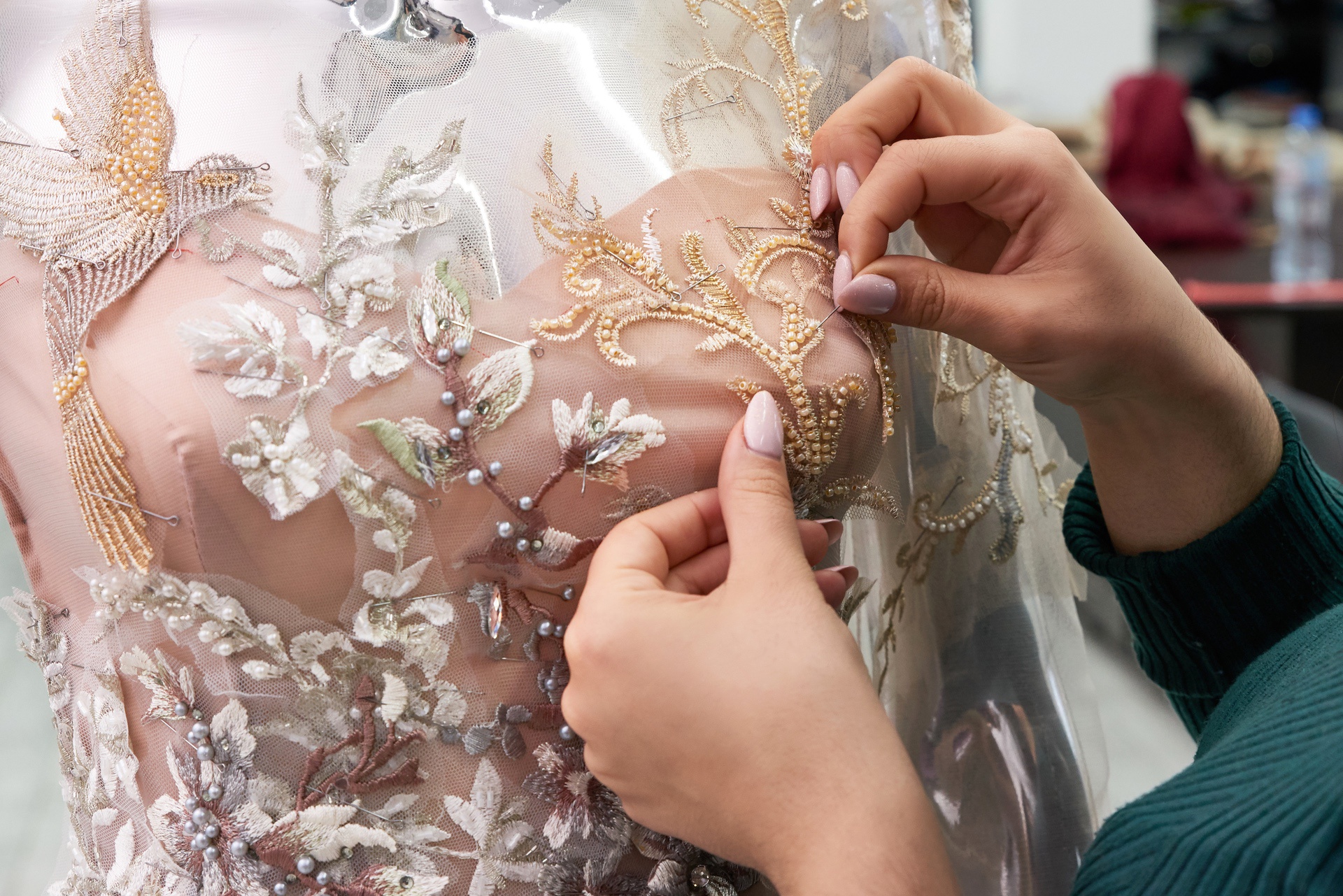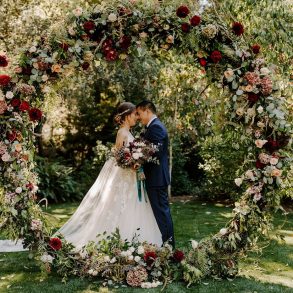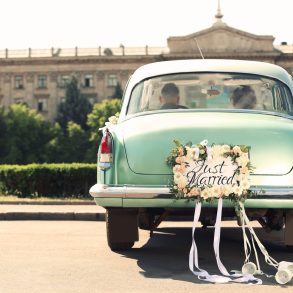If you’re a very lucky bride, you’ll find a wedding dress that fits you perfectly. For everyone else, alterations are essential.
To be super clear, there is a difference between an alteration and a repair. An alteration is when you add or remove something from a dress while a repair is mending or restoring something on your dress. Below, we’ll break down some examples of each that can be done at the bridal salon where you bought the gown or at a local seamstress.

Alterations
Alterations ensure your gown not only fits you well but can give you a totally customized look on your wedding day. No matter the reason for the alteration, be sure to factor this must-have cost into your wedding dress budget. Here are some common alterations made to wedding dresses.
Taking In/Letting Out a Dress
Dresses can be taken in or let out about two inches, meaning you can alter them to fit one size smaller or one size larger than the original dress size. To accomplish this, the seamstress opens the seams where the dress needs to be adjusted (typically around the hips or waist). They can also adjust the area around the bust.
Altering the Hem/Length of a Dress
Many dresses come with an extra-long hem to accompany brides of average-to-taller heights. So, if you’re a shorter bride, you’ll most likely need to shorten the hem. The seamstress may need to take off any lace or additional layers at the bottom of your dress to make this work, but they should be able to sew the embellishments back on if you still want to keep that detailing.
Another common alteration in this category is to add train loops to bustle the dress. This allows the bride to lift the train later in the day—typically after the ceremony, so she can move around more freely. There are different types of bustles, so work with your seamstress to determine the best style for your dress.

Adding Extra Elements
Some brides find the perfect gown but then realize something’s missing, so they decide to add to the dress to make it their own creation! Your bridal salon can help recommend certain additions that they’ve done in the past, including adding sleeves or straps, adding beading or lace embellishments, adding a sash or bow, or adding a lining to a sheer silhouette.
They can also sew a bra into your wedding gown to eliminate the need for a specialty brassiere. Of course, some additions will cost more than others (and take more or less time), so be sure to keep your budget in mind before you do a full redesign.
Reworking Elements of the Dress
If you’re not looking to add anything to your dress, consider re-working or removing certain elements. Some of the simpler alterations include shortening the length of your straps or removing a few layers to make your dress lay flatter.
For a more extensive alteration, consider changing up the neckline. A trained seamstress can easily add fabric, remove collars, or turn a simple v-neck into a plunging v-neck. They can also make changes to the back of your dress like adding lace to a strapless gown, but keep in mind this will cost more.
You could also add a long line of buttons to cover the zipper in the back or remove the zipper altogether and exchange it for a corset back. It’s a common and easy alteration to make!

Wedding Dress Repairs
While alterations are typically a happy change to your gown, a repair usually means something needs to be fixed. This ranges from mending a tear to securing loose embellishments and more. Here are some simple repairs that can be done to your dress.
Close a Popped Seam
A popped seam is an easy fix, but depending how much thread has unraveled, you may want to get this repair done by a professional. The seamstress will simply stitch up the seam with the existing thread or new thread. If they’re using a new thread, they’ll try to match it up to the original color as close as possible.

Replace a Lost Button
Replacing a lost button is another easy repair, but it depends on which button is missing. If you’re missing a button from your sleeve or back of the dress, heading to the bridal shop is your best bet. They’re more likely to have specialty buttons.
If it’s a smaller button, like the one on your bustle, your local seamstress should be able to replace it. The good news is that your wedding dress should come with one or two spare buttons anyways, so this may not be a huge issue.
Fix a Broken Zipper
There are two options when dealing with a broken zipper: replace the zipper or lose the zipper and convert your back closure to a corset. Simply repairing a broken zipper will cost less money, but you could turn a repair into an alteration if you’re afraid the zipper will cause future issues.
In case of a wedding day emergency, another option is to stitch the dress shut (you read that right). This is only recommended if you’re already in the dress and don’t have time to fix the zipper. Luckily, sewing up your dress should only take about 5 minutes—and then you’re back to celebration mode.

Restring Loose Embellishments
If you’re wearing your dress before the big day (like for your bridal portraits) there is a chance that some of your embellishments could become loose. A seamstress should be able to restring any loose beading, lace, or applique. However, some professionals are hesitant to make this repair and fear they’ll ruin the embellishment in the end. Just ask the seamstress about their comfort level and experience before handing over your gown.
Steam Out Wrinkles
Another thing to look out for is wrinkles on your dress. Even if the dress hasn’t left your closet, it’s good to give it a quick steam before the ceremony.
To avoid wet spots or ruining the dress completely, get your gown professionally steamed. The bridal salon where you bought the gown can provide this service and it’s usually cheap. If you’re traveling out of town for your wedding, wait until you reach your destination to get it steamed.
We highly recommend purchasing a bridal emergency kit in case any of these last-minute repairs need to be done on the day of your wedding. Hopefully you won’t need to use it, but you’ll be thankful you have one if you do.










